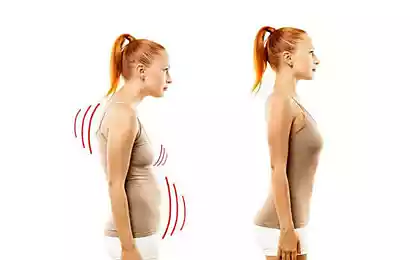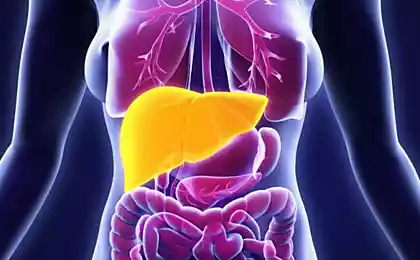642
10 barriers to healthy and beautiful belly
Question stomach is confusing many people. So I disassembled the top 10 mistakes made by people who begin to "pump the stomach."
1. The percentage of fat in the body.
It is impossible to buy beautiful belly, if you have elevated levels of subcutaneous fat in the body. Your way is the right diet regime and physical activity (training and non-training), it is important societati as prolonged low intensity load and short intense exercise.
Remember that no relationship between the AB workout and belly fat not. Understand that the abdominal rectus muscles are muscles that do not provide the shape of the abdomen and flexing the spine. So there are a huge number of muscular man with cubes and big bellies. Also the rectus abdominis along with the oblique and transverse, and contributes to the preservation of intra-abdominal pressure, helping the extensors of the spine. And among the rest of the muscles that support the internal abdominal pressure – oblique and transverse, the role of the straight is very small.
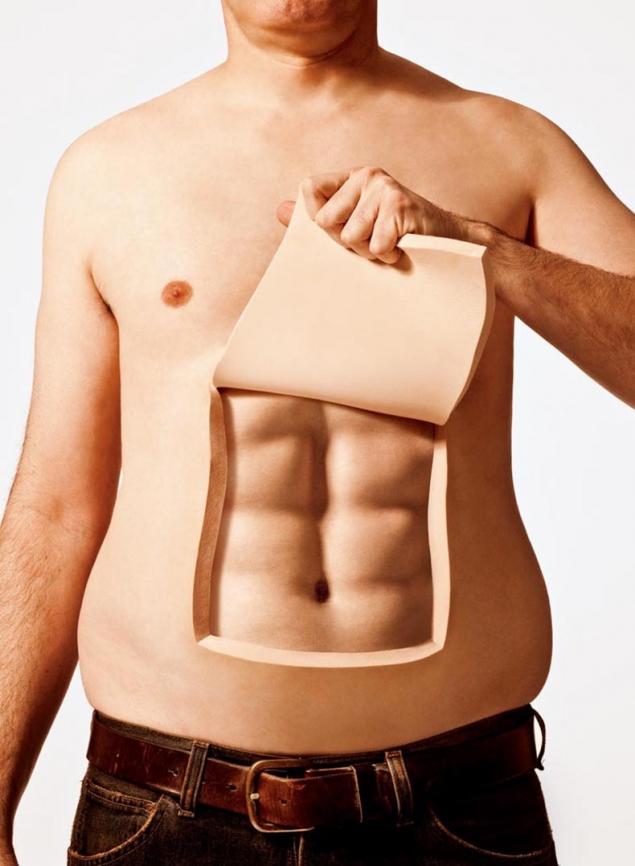
What to do?
To measure the level of subcutaneous fat with the downhillers. To calculate your optimum percentage of body fat in the body and keep it within normal limits. Don't go beyond in both directions! Normal levels of subcutaneous fat secretes hormones leptin, adiponectin. And in women after menopause subcutaneous fat is an important source of estrogen. This is easily achieved good nutrition, physical activity.

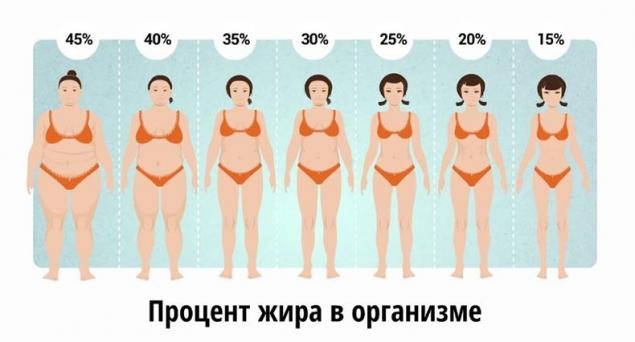
2. Visceral fat.
Visceral fat is deposited inside the abdominal cavity (liver, bowel loops, about the kidneys, etc.) and leads to protrusion of the abdomen. The problem is that to measure it directly is very difficult, "the greatest enemy will hide where you least expect to see him." To suspect an excess of visceral fat can be about the increase in waist size and height of the abdomen. Also, excess visceral fat can be determined on ultrasound and MRI: ultrasound is fatty liver.
The problem is that often visceral fat is not associated with excess weight. People with excess visceral fat can have a normal and even reduced body weight. Why? They may have little subcutaneous fat and weak muscles, so the total weight is within the normal range. Excess fat component of body composition (visceral fat) is found in 63.8% of young women and 53,78% of men with normal values of waist circumference (FROM) and body mass index. More rigorous studies suggest that 10% of men and 11% of women with severe excess visceral fat. Ie apparently thin people can be fat inside.
What to do?
Physical activity and nutrition. Pay special attention to the prevention of exhaustion: the physical and food. Pietrini and fasting strictly prohibited! Calculate your minimum calories, and not to cross it. Observe the anti-stress mode, and learn the basics of time-manegment.
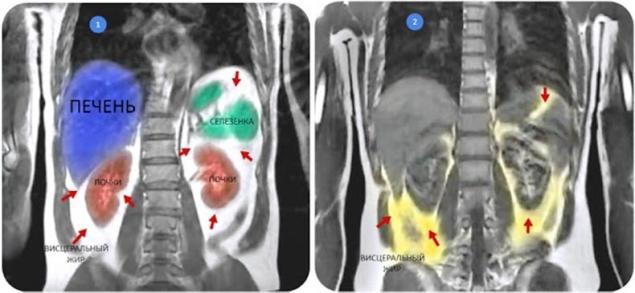
3. Trap fat.
A very common problem are the traps fat in the abdominal area. Traps fat arise from hereditary characteristics of the organism or in the case of metabolic disorders. The exchange of fat depends on the balance of adrenergic receptors in fat cells. For example, in the lower body (legs and hips) to 9 times more receptors alpha-2 than beta-2. According to some, fat in the belly area in men has similar characteristics, i.e., alpha-2 receptors more than beta-2.
It turned out that the men in the lower part of the abdomen is dominated by the A2 adrenergic receptors, and this explains why this area accumulates fat tissue among the first, and part with fat accumulation of the latter. Also men often fat in the form of a band (donut), and the setting on the back.
Regarding visceral fat, belly fat (and perhaps in the lower back) are less sensitive to the mobilizing effects of the catecholamines, more sensitive to insulin, and blood circulation there is less active. This makes it more stubborn than visceral. Moreover, in the traps of fat bad blood circulation, which greatly complicates the mobilization and transport of fatty acids. In fact, actually, that's not entirely true, blood circulation in problem areas is not always slow. After eating blood flow to problem areas becomes much more active; but all the rest of the time, Yes, blood flow in these areas is slowing. Physical activity also slows down blood flow to problem areas.
What to do?
First and foremost is the normalization of metabolism and hormones. Important local study of the problem areas + following physical activity. The local study includes lymphatic drainage, massage, cryotherapy (but not necessarily in conjunction with the total activity). The necessary reduction of sources of chronic stress, the increase in the number of acute stress with high-quality recovery.
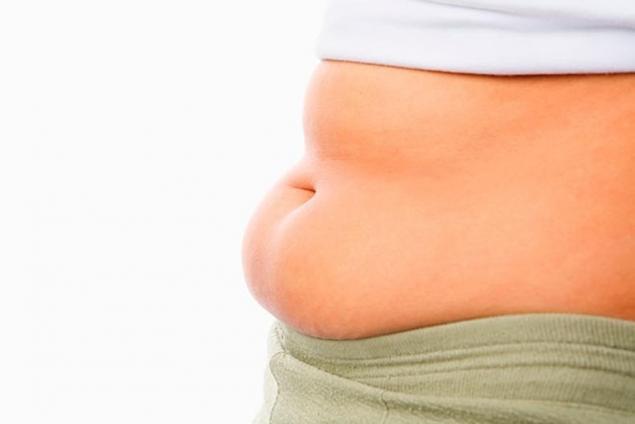
4. Aerophagia
The increase of stomach tension discomfort may occur due to ingestion of large quantities of air. Aerophagia — increased swallowing of air while eating. The signs are bloating, mainly in the upper part; the hiccups. As a consequence of aerophagia can cause pilorospazme at the junction of the stomach and duodenum, spasm of the sphincter.
What to do?
For the prevention of aerophagia recommended: chew food thoroughly (until it turns into a liquid slurry); no talking during meals. Also helps treatment of mental disorders. Reduce the amount of air you swallow during meals, chewing gum and Smoking. Eat slower and chew with the most mouth closed to prevent swallowing air. A list of activities that you swallow air are: rapid drinking, chewing gum, using tobacco products, the hyperventilation caused by anxiety.


5. Flatulence
The increase in the volume of the stomach caused by excessive gas formation. Flatulence is always secondary to the syndrome and reflects the course of the underlying disease or problems, therefore the main attention should be paid to the treatment of primary disease or problem. Flatulence can be caused by disease, improper handling of food, intolerance. Fresh vegetables and fruits can cause gas in those who typically eat processed foods. It usually passes after a few days. Do not stop eating vegetables. Some help easy heat treatment (boil, steam) Can cause gas: artichokes, asparagus, broccoli, Brussels sprouts, cabbage, cauliflower, zucchini, cucumbers, peppers, onions, peas, radishes, and raw potatoes. Fruits such as apricots, bananas, melons, peaches, pears, prunes and raw apples.
What to do?
The identification and elimination of neperenosimosti, to avoid abrupt changes in the amount of vegetables, avoid excessive fiber, to avoid a large number of raw vegetables that cause flatulence.
6. Intra-abdominal pressure and the abdominal muscles.
To weaken the abdominal muscles can long the factors that acutely increase intraabdominal pressure. This leads to pererastayut abdominal muscles and pelvic floor. This leads to a weakening of the transverse abdominal muscles and loss of its shape. Violations of normal processes of urination (stricture), defecation (constipation, diarrhea) lead to an increase in intra-abdominal pressure and long cough, childbirth, excessive tightening of the stomach, improper lifting, breaches of exercise also contribute to increased intra-abdominal pressure. Intra-abdominal pressure, elevating Tacloban, acting continuously over a long period of time weakens the abdominal muscles.
What to do?
To strengthen core muscles and learn how to start any movement with the core muscles. Normal intra-abdominal pressure helps you to stabilize the spine. Breathe right (uh-HY) and strain (and not bring!) the stomach. Pick up the pelvis and abdomen (straining the pelvic floor and abdomen, but not to push!) during exercise, to treat cough, how to recover after childbirth. Work well exercises to strengthen the transverse abdominal muscles, thoracic diaphragm and pelvic diaphragm.
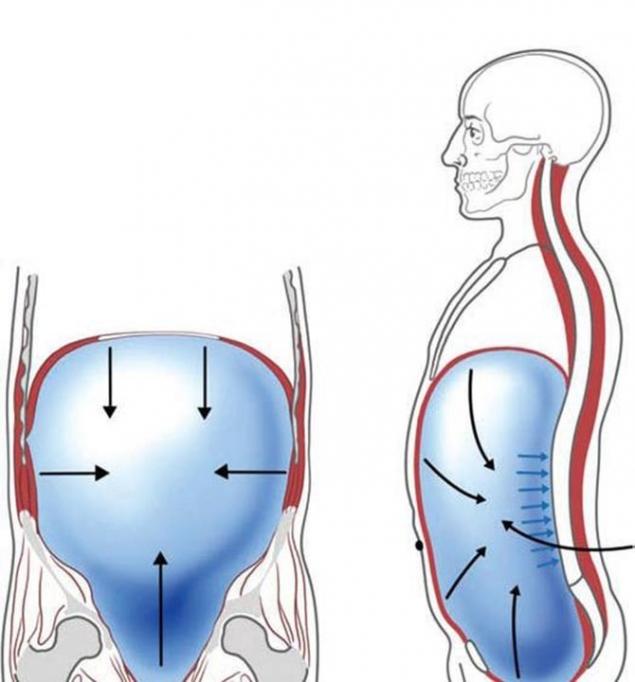
7. Inflammatory dyskinetic bowel problems.
Violations of movement (motility) of the intestines delay in this chyme and feces, which contributes to the increase its volume. Inflammation of the intestine causes a delay in it liquid. Delay feces is a key factor in the development of colon cancer, appendicitis and inflammatory bowel disease (including irritable bowel syndrome). Normal defecation preserves healthy adjacent organs: prostate, bladder, and urethra. Unhealthy posture can disrupt the functioning of the muscles of the pelvic floor and the urogenital diaphragm.
What to do?
To learn how to make bowel movement in a healthy posture in a healthy way. For a normal healthy bowel movement you want to do three things: to go to the bathroom, to relax the sphincter and feel the process of defecation. All that lies beyond these three functions, unnecessary, pathological and leads to the emergence of a large number of complications and difficulties.
8. Upper and lower cross syndromes.
Incorrect posture leads to a strong violation of the form of the abdomen. The main posture is the upper and lower cross syndromes. In upper cross syndrome is caused stooped posture, the head is pushed forward, the lower ribs and pelvis like a shrink, causing the centre of your stomach to fall inward, minimizing the deflection in the lower back, the abdomen bulges.
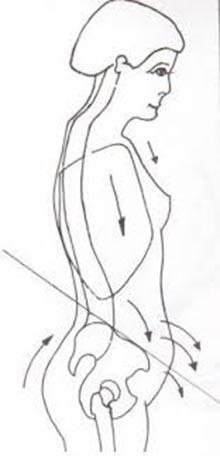
In lower cross syndrome is reversal of the pelvis forward. Because, again, a sedentary lifestyle, the inclination angle of the pelvis increases, taking the glutes back and chest forward and up. Abdominal muscles while you relax, leaving the stress on the lower back. The result is fall belly, and chronic back pain. Note that strength training in this posture will only aggravate the problem even more overloading the lower back.
What to do?
To improve working ergonomics, to minimize the time sedentary work, to start working on posture, move more. Use caution when strength training.

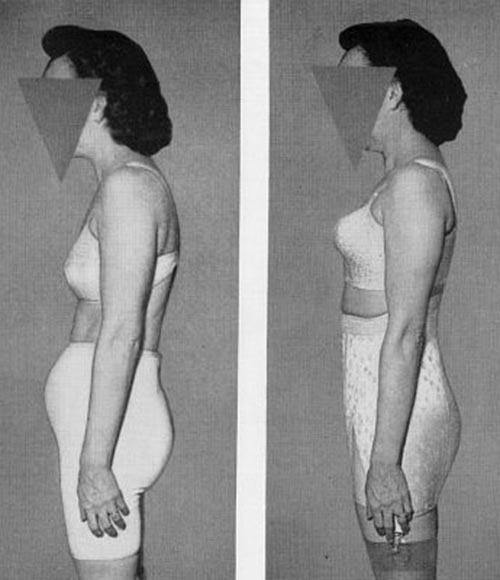
9. Sagging belly.
The problem: the change in the structure of the abdomen, fat accumulates between the muscle belly and the muscle size decreases. In addition, the recovery rate of the skin slows down, it becomes thinner and loses its tone, SAG (due to the destruction of collagen and elastic fibers). Also very common causes for sagging skin of the abdomen are quick weight loss sets of weight and pregnancy and childbirth. Thumb and forefinger pinch the skin on the back of her hand, slightly pulling it, and hold so for 5 seconds. Now let's see how long will traces of pinching. If you are under 45 years old; they will disappear in 5 seconds if 60 – 10-15 if 70 – for 35-55 seconds.
What to do?
To check the level of growth hormone and melatonin. Nutrition and exercise, contribute to the normalization of growth hormone. Growth hormone is also responsible for skin hydration, tone, volume, and tone subdermal muscles. No wonder he is called "anti-aging hormone". The level of this hormone is subject to significant age variations. Reduce the number appears in the gravitational ptosis of facial tissues ("flowing" entity), pronounced nasolabial folds, the appearance of vertical wrinkles on the lateral surfaces of the cheeks, thinning of lips (lip "thread"). All the skin of the face and neck becomes dry and thin "parchment". Deposition of fat under the chin and sagging neck-chin angle form the so-called "Turkey neck".
10. Unwanted attention to the belly.
If You started to do them just because of the belly, You better reconsider motivation. Respect your whole body and engage them harmoniously and without radicalism. Be careful and patient, learn to recognize your body's needs and properly satisfy them. And then your body will reward you with beauty. After all, beauty is excess health. published
Author: Andrey Blueskin
P. S. And remember, only by changing their consumption — together we change the world! ©
Join us in Facebook , Vkontakte, Odnoklassniki
Source: www.beloveshkin.com/2015/10/10-prepyatstvij-dlya-krasivogo-zhivota-ssylki.html
1. The percentage of fat in the body.
It is impossible to buy beautiful belly, if you have elevated levels of subcutaneous fat in the body. Your way is the right diet regime and physical activity (training and non-training), it is important societati as prolonged low intensity load and short intense exercise.
Remember that no relationship between the AB workout and belly fat not. Understand that the abdominal rectus muscles are muscles that do not provide the shape of the abdomen and flexing the spine. So there are a huge number of muscular man with cubes and big bellies. Also the rectus abdominis along with the oblique and transverse, and contributes to the preservation of intra-abdominal pressure, helping the extensors of the spine. And among the rest of the muscles that support the internal abdominal pressure – oblique and transverse, the role of the straight is very small.

What to do?
To measure the level of subcutaneous fat with the downhillers. To calculate your optimum percentage of body fat in the body and keep it within normal limits. Don't go beyond in both directions! Normal levels of subcutaneous fat secretes hormones leptin, adiponectin. And in women after menopause subcutaneous fat is an important source of estrogen. This is easily achieved good nutrition, physical activity.


2. Visceral fat.
Visceral fat is deposited inside the abdominal cavity (liver, bowel loops, about the kidneys, etc.) and leads to protrusion of the abdomen. The problem is that to measure it directly is very difficult, "the greatest enemy will hide where you least expect to see him." To suspect an excess of visceral fat can be about the increase in waist size and height of the abdomen. Also, excess visceral fat can be determined on ultrasound and MRI: ultrasound is fatty liver.
The problem is that often visceral fat is not associated with excess weight. People with excess visceral fat can have a normal and even reduced body weight. Why? They may have little subcutaneous fat and weak muscles, so the total weight is within the normal range. Excess fat component of body composition (visceral fat) is found in 63.8% of young women and 53,78% of men with normal values of waist circumference (FROM) and body mass index. More rigorous studies suggest that 10% of men and 11% of women with severe excess visceral fat. Ie apparently thin people can be fat inside.
What to do?
Physical activity and nutrition. Pay special attention to the prevention of exhaustion: the physical and food. Pietrini and fasting strictly prohibited! Calculate your minimum calories, and not to cross it. Observe the anti-stress mode, and learn the basics of time-manegment.

3. Trap fat.
A very common problem are the traps fat in the abdominal area. Traps fat arise from hereditary characteristics of the organism or in the case of metabolic disorders. The exchange of fat depends on the balance of adrenergic receptors in fat cells. For example, in the lower body (legs and hips) to 9 times more receptors alpha-2 than beta-2. According to some, fat in the belly area in men has similar characteristics, i.e., alpha-2 receptors more than beta-2.
It turned out that the men in the lower part of the abdomen is dominated by the A2 adrenergic receptors, and this explains why this area accumulates fat tissue among the first, and part with fat accumulation of the latter. Also men often fat in the form of a band (donut), and the setting on the back.
Regarding visceral fat, belly fat (and perhaps in the lower back) are less sensitive to the mobilizing effects of the catecholamines, more sensitive to insulin, and blood circulation there is less active. This makes it more stubborn than visceral. Moreover, in the traps of fat bad blood circulation, which greatly complicates the mobilization and transport of fatty acids. In fact, actually, that's not entirely true, blood circulation in problem areas is not always slow. After eating blood flow to problem areas becomes much more active; but all the rest of the time, Yes, blood flow in these areas is slowing. Physical activity also slows down blood flow to problem areas.
What to do?
First and foremost is the normalization of metabolism and hormones. Important local study of the problem areas + following physical activity. The local study includes lymphatic drainage, massage, cryotherapy (but not necessarily in conjunction with the total activity). The necessary reduction of sources of chronic stress, the increase in the number of acute stress with high-quality recovery.

4. Aerophagia
The increase of stomach tension discomfort may occur due to ingestion of large quantities of air. Aerophagia — increased swallowing of air while eating. The signs are bloating, mainly in the upper part; the hiccups. As a consequence of aerophagia can cause pilorospazme at the junction of the stomach and duodenum, spasm of the sphincter.
What to do?
For the prevention of aerophagia recommended: chew food thoroughly (until it turns into a liquid slurry); no talking during meals. Also helps treatment of mental disorders. Reduce the amount of air you swallow during meals, chewing gum and Smoking. Eat slower and chew with the most mouth closed to prevent swallowing air. A list of activities that you swallow air are: rapid drinking, chewing gum, using tobacco products, the hyperventilation caused by anxiety.


5. Flatulence
The increase in the volume of the stomach caused by excessive gas formation. Flatulence is always secondary to the syndrome and reflects the course of the underlying disease or problems, therefore the main attention should be paid to the treatment of primary disease or problem. Flatulence can be caused by disease, improper handling of food, intolerance. Fresh vegetables and fruits can cause gas in those who typically eat processed foods. It usually passes after a few days. Do not stop eating vegetables. Some help easy heat treatment (boil, steam) Can cause gas: artichokes, asparagus, broccoli, Brussels sprouts, cabbage, cauliflower, zucchini, cucumbers, peppers, onions, peas, radishes, and raw potatoes. Fruits such as apricots, bananas, melons, peaches, pears, prunes and raw apples.
What to do?
The identification and elimination of neperenosimosti, to avoid abrupt changes in the amount of vegetables, avoid excessive fiber, to avoid a large number of raw vegetables that cause flatulence.
6. Intra-abdominal pressure and the abdominal muscles.
To weaken the abdominal muscles can long the factors that acutely increase intraabdominal pressure. This leads to pererastayut abdominal muscles and pelvic floor. This leads to a weakening of the transverse abdominal muscles and loss of its shape. Violations of normal processes of urination (stricture), defecation (constipation, diarrhea) lead to an increase in intra-abdominal pressure and long cough, childbirth, excessive tightening of the stomach, improper lifting, breaches of exercise also contribute to increased intra-abdominal pressure. Intra-abdominal pressure, elevating Tacloban, acting continuously over a long period of time weakens the abdominal muscles.
What to do?
To strengthen core muscles and learn how to start any movement with the core muscles. Normal intra-abdominal pressure helps you to stabilize the spine. Breathe right (uh-HY) and strain (and not bring!) the stomach. Pick up the pelvis and abdomen (straining the pelvic floor and abdomen, but not to push!) during exercise, to treat cough, how to recover after childbirth. Work well exercises to strengthen the transverse abdominal muscles, thoracic diaphragm and pelvic diaphragm.

7. Inflammatory dyskinetic bowel problems.
Violations of movement (motility) of the intestines delay in this chyme and feces, which contributes to the increase its volume. Inflammation of the intestine causes a delay in it liquid. Delay feces is a key factor in the development of colon cancer, appendicitis and inflammatory bowel disease (including irritable bowel syndrome). Normal defecation preserves healthy adjacent organs: prostate, bladder, and urethra. Unhealthy posture can disrupt the functioning of the muscles of the pelvic floor and the urogenital diaphragm.
What to do?
To learn how to make bowel movement in a healthy posture in a healthy way. For a normal healthy bowel movement you want to do three things: to go to the bathroom, to relax the sphincter and feel the process of defecation. All that lies beyond these three functions, unnecessary, pathological and leads to the emergence of a large number of complications and difficulties.
8. Upper and lower cross syndromes.
Incorrect posture leads to a strong violation of the form of the abdomen. The main posture is the upper and lower cross syndromes. In upper cross syndrome is caused stooped posture, the head is pushed forward, the lower ribs and pelvis like a shrink, causing the centre of your stomach to fall inward, minimizing the deflection in the lower back, the abdomen bulges.

In lower cross syndrome is reversal of the pelvis forward. Because, again, a sedentary lifestyle, the inclination angle of the pelvis increases, taking the glutes back and chest forward and up. Abdominal muscles while you relax, leaving the stress on the lower back. The result is fall belly, and chronic back pain. Note that strength training in this posture will only aggravate the problem even more overloading the lower back.
What to do?
To improve working ergonomics, to minimize the time sedentary work, to start working on posture, move more. Use caution when strength training.


9. Sagging belly.
The problem: the change in the structure of the abdomen, fat accumulates between the muscle belly and the muscle size decreases. In addition, the recovery rate of the skin slows down, it becomes thinner and loses its tone, SAG (due to the destruction of collagen and elastic fibers). Also very common causes for sagging skin of the abdomen are quick weight loss sets of weight and pregnancy and childbirth. Thumb and forefinger pinch the skin on the back of her hand, slightly pulling it, and hold so for 5 seconds. Now let's see how long will traces of pinching. If you are under 45 years old; they will disappear in 5 seconds if 60 – 10-15 if 70 – for 35-55 seconds.
What to do?
To check the level of growth hormone and melatonin. Nutrition and exercise, contribute to the normalization of growth hormone. Growth hormone is also responsible for skin hydration, tone, volume, and tone subdermal muscles. No wonder he is called "anti-aging hormone". The level of this hormone is subject to significant age variations. Reduce the number appears in the gravitational ptosis of facial tissues ("flowing" entity), pronounced nasolabial folds, the appearance of vertical wrinkles on the lateral surfaces of the cheeks, thinning of lips (lip "thread"). All the skin of the face and neck becomes dry and thin "parchment". Deposition of fat under the chin and sagging neck-chin angle form the so-called "Turkey neck".
10. Unwanted attention to the belly.
If You started to do them just because of the belly, You better reconsider motivation. Respect your whole body and engage them harmoniously and without radicalism. Be careful and patient, learn to recognize your body's needs and properly satisfy them. And then your body will reward you with beauty. After all, beauty is excess health. published
Author: Andrey Blueskin
P. S. And remember, only by changing their consumption — together we change the world! ©
Join us in Facebook , Vkontakte, Odnoklassniki
Source: www.beloveshkin.com/2015/10/10-prepyatstvij-dlya-krasivogo-zhivota-ssylki.html









